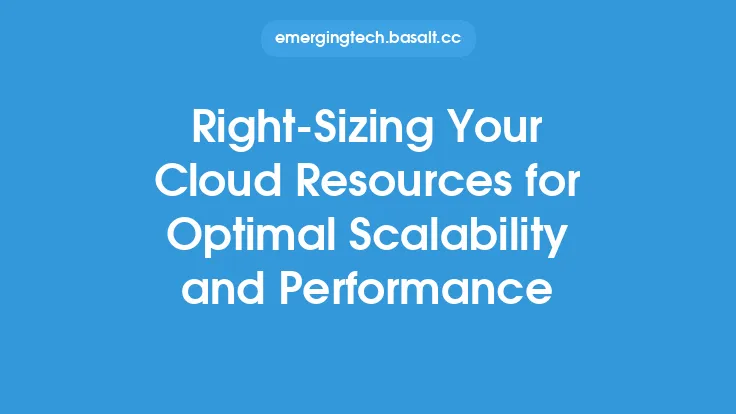Handling seasonal traffic and peak demand is a crucial aspect of cloud scalability, as it enables businesses to adapt to fluctuating workloads and ensure high availability and performance of their applications. Seasonal traffic refers to the periodic increase in workload due to events such as holidays, sales, or special promotions, while peak demand refers to the sudden and unexpected surge in workload. To effectively handle these scenarios, businesses must employ cloud scalability strategies that allow them to quickly scale up or down to match changing demand.
Introduction to Cloud Scalability Strategies
Cloud scalability strategies for handling seasonal traffic and peak demand involve a combination of planning, architecture, and technology. The primary goal is to ensure that the application can handle increased traffic without compromising performance, while also minimizing costs and optimizing resource utilization. This can be achieved through a variety of techniques, including load balancing, caching, content delivery networks (CDNs), and autoscaling. Load balancing distributes incoming traffic across multiple servers to prevent any single server from becoming overwhelmed, while caching stores frequently accessed data in memory to reduce the load on databases and improve response times. CDNs, on the other hand, cache content at edge locations closer to users, reducing latency and improving performance.
Planning and Preparation
Effective planning and preparation are essential for handling seasonal traffic and peak demand. This involves analyzing historical traffic patterns, forecasting future demand, and identifying potential bottlenecks in the application. Businesses should also develop a scalability plan that outlines the steps to be taken in case of increased traffic, including the deployment of additional resources, the implementation of load balancing and caching, and the optimization of database queries. Additionally, businesses should conduct regular stress testing and performance monitoring to identify areas for improvement and ensure that the application can handle increased traffic without compromising performance.
Architecture and Design
A well-designed architecture is critical for handling seasonal traffic and peak demand. This involves designing the application to be highly available, scalable, and fault-tolerant. Businesses should adopt a microservices architecture, which allows them to break down the application into smaller, independent services that can be scaled individually. This approach also enables businesses to use multiple programming languages, frameworks, and databases, depending on the specific requirements of each service. Furthermore, businesses should use cloud-native services, such as serverless computing, containers, and functions, which provide greater flexibility and scalability than traditional virtual machines.
Load Balancing and Autoscaling
Load balancing and autoscaling are critical components of cloud scalability strategies for handling seasonal traffic and peak demand. Load balancing distributes incoming traffic across multiple servers, preventing any single server from becoming overwhelmed. Autoscaling, on the other hand, automatically adds or removes servers based on changing demand, ensuring that the application has the necessary resources to handle increased traffic. Businesses should use cloud providers' built-in load balancing and autoscaling services, which provide advanced features such as predictive scaling, scheduled scaling, and dynamic scaling. Additionally, businesses should use third-party load balancing and autoscaling tools, which provide greater flexibility and customization options.
Caching and Content Delivery Networks
Caching and content delivery networks (CDNs) are essential for improving performance and reducing latency in cloud applications. Caching stores frequently accessed data in memory, reducing the load on databases and improving response times. CDNs, on the other hand, cache content at edge locations closer to users, reducing latency and improving performance. Businesses should use cloud providers' built-in caching and CDN services, which provide advanced features such as automatic caching, cache invalidation, and SSL/TLS encryption. Additionally, businesses should use third-party caching and CDN tools, which provide greater flexibility and customization options.
Database Optimization
Database optimization is critical for handling seasonal traffic and peak demand. This involves optimizing database queries, indexing, and schema design to improve performance and reduce latency. Businesses should use cloud providers' built-in database services, which provide advanced features such as automatic indexing, query optimization, and connection pooling. Additionally, businesses should use third-party database tools, which provide greater flexibility and customization options. Furthermore, businesses should adopt a database-as-a-service (DBaaS) approach, which provides greater scalability, flexibility, and cost-effectiveness than traditional database deployments.
Security and Monitoring
Security and monitoring are essential for ensuring the availability and performance of cloud applications during seasonal traffic and peak demand. Businesses should use cloud providers' built-in security services, which provide advanced features such as firewalls, intrusion detection, and encryption. Additionally, businesses should use third-party security tools, which provide greater flexibility and customization options. Furthermore, businesses should adopt a monitoring-as-a-service (MaaS) approach, which provides real-time monitoring, alerting, and analytics for cloud applications. This enables businesses to quickly identify and respond to performance issues, security threats, and other problems that may arise during seasonal traffic and peak demand.
Conclusion
In conclusion, handling seasonal traffic and peak demand is a critical aspect of cloud scalability, and businesses must employ a range of strategies to ensure high availability and performance of their applications. This involves planning and preparation, architecture and design, load balancing and autoscaling, caching and content delivery networks, database optimization, security, and monitoring. By adopting these strategies, businesses can ensure that their cloud applications can handle increased traffic without compromising performance, while also minimizing costs and optimizing resource utilization. As the demand for cloud computing continues to grow, businesses must prioritize cloud scalability to remain competitive and provide high-quality services to their customers.





